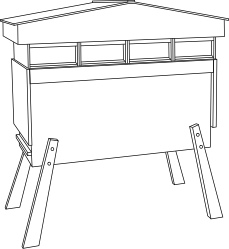Dartington Long Deep Hive
The Dartington long deep hive was developed in 1975 by Robin Dartington, an engineer.
The hives are intended for use in gardens and on roof top locations, not for commercial or migratory beekeeping.
They are designed to keep the weight of individual parts below 7kg (16 lbs), which observes the safety guidance issued by the UK Health & Safety Executive. The hive is therefore safe for use by everyone.
The design is derived from classic log hives used around the world where honey is stored by the bees at the back of the cavity away from the entrance. However, the system is very flexible as the brood chamber can be divided to house two or more colonies plus honey boxes may be added above the brood chamber to provide as much honey storage as required.
| HIVE DATA | NATIONAL 14×12 | DARTINGTON | BEEHAUS |
|---|---|---|---|
| Brood frame | 14″ x 12″ | 14″ x 12″ | 14″ x 12″ |
| Super frame | 14″ x 5½” | 14″ x 5½” | 14″ x 5½” |
| Frames / brood box | 11 | 21 | 22 |
| Cells / brood box | 80,000 | 80,000 | 80,000 |
| Lug length | 1½” | 1½” | 1½” |
The construction uses widely available modern materials such as plywood. Essentially, the hive is a rectangular brood chamber based on the National 14 x 12 frame with top bee space.
The hive holds 21 frames (14” wide x 12” deep) with an insulated dummy board front and back. The body is raised to a convenient working height on long legs and supports four or more honey-boxes above the brood chamber each holding five Manley frames or six National shallow frames (14” x 5½”).
A fifth honey-box is provided to allow exchange of a full box for an empty one or it can be used as a queen mating hive.
Accessories include two carry-boxes, each holding six 14 x 12 frames for winter storage. A carry-box can also be used in summer as a nucleus hive using the fifth cover board as a roof.

The Dartington comes with a division board to split the body into two separate compartments, enabling effective swarm control.